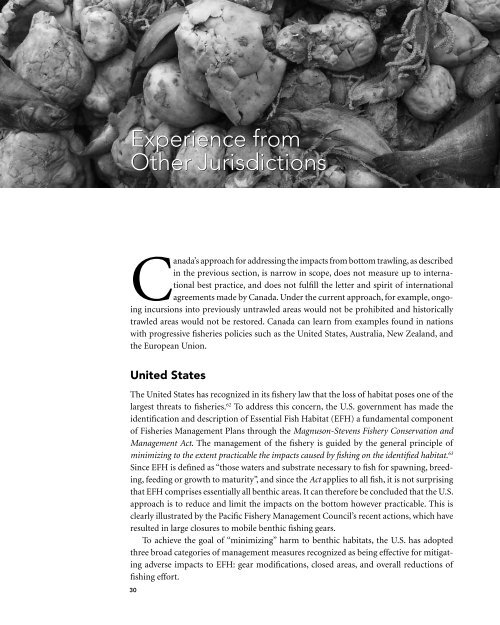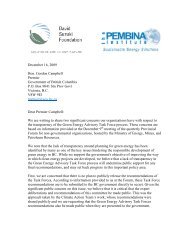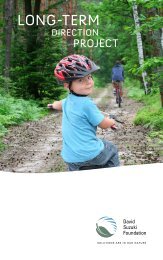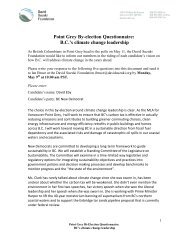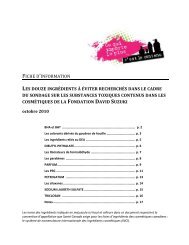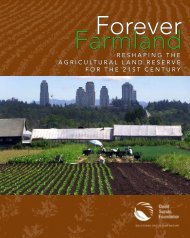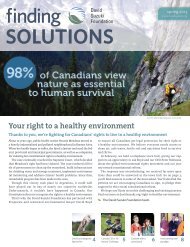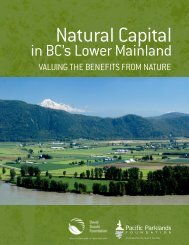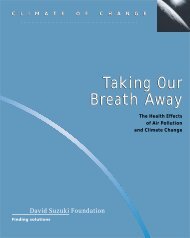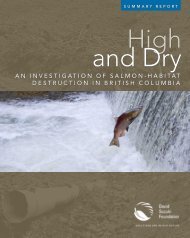Toward an Ecosystem Approach to Bottom Trawling in Canada
Toward an Ecosystem Approach to Bottom Trawling in Canada
Toward an Ecosystem Approach to Bottom Trawling in Canada
- No tags were found...
You also want an ePaper? Increase the reach of your titles
YUMPU automatically turns print PDFs into web optimized ePapers that Google loves.
Experience fromOther JurisdictionsC<strong>an</strong>ada’s approach for address<strong>in</strong>g the impacts from bot<strong>to</strong>m trawl<strong>in</strong>g, as described<strong>in</strong> the previous section, is narrow <strong>in</strong> scope, does not measure up <strong>to</strong> <strong>in</strong>ternationalbest practice, <strong>an</strong>d does not fulfill the letter <strong>an</strong>d spirit of <strong>in</strong>ternationalagreements made by C<strong>an</strong>ada. Under the current approach, for example, ongo<strong>in</strong>g<strong>in</strong>cursions <strong>in</strong><strong>to</strong> previously untrawled areas would not be prohibited <strong>an</strong>d his<strong>to</strong>ricallytrawled areas would not be res<strong>to</strong>red. C<strong>an</strong>ada c<strong>an</strong> learn from examples found <strong>in</strong> nationswith progressive fisheries policies such as the United States, Australia, New Zeal<strong>an</strong>d, <strong>an</strong>dthe Europe<strong>an</strong> Union.United StatesThe United States has recognized <strong>in</strong> its fishery law that the loss of habitat poses one of thelargest threats <strong>to</strong> fisheries. 62 To address this concern, the U.S. government has made theidentification <strong>an</strong>d description of Essential Fish Habitat (EFH) a fundamental componen<strong>to</strong>f Fisheries M<strong>an</strong>agement Pl<strong>an</strong>s through the Magnuson-Stevens Fishery Conservation <strong>an</strong>dM<strong>an</strong>agement Act. The m<strong>an</strong>agement of the fishery is guided by the general pr<strong>in</strong>ciple ofm<strong>in</strong>imiz<strong>in</strong>g <strong>to</strong> the extent practicable the impacts caused by fish<strong>in</strong>g on the identified habitat. 63S<strong>in</strong>ce EFH is def<strong>in</strong>ed as “those waters <strong>an</strong>d substrate necessary <strong>to</strong> fish for spawn<strong>in</strong>g, breed<strong>in</strong>g,feed<strong>in</strong>g or growth <strong>to</strong> maturity”, <strong>an</strong>d s<strong>in</strong>ce the Act applies <strong>to</strong> all fish, it is not surpris<strong>in</strong>gthat EFH comprises essentially all benthic areas. It c<strong>an</strong> therefore be concluded that the U.S.approach is <strong>to</strong> reduce <strong>an</strong>d limit the impacts on the bot<strong>to</strong>m however practicable. This isclearly illustrated by the Pacific Fishery M<strong>an</strong>agement Council’s recent actions, which haveresulted <strong>in</strong> large closures <strong>to</strong> mobile benthic fish<strong>in</strong>g gears.To achieve the goal of “m<strong>in</strong>imiz<strong>in</strong>g” harm <strong>to</strong> benthic habitats, the U.S. has adoptedthree broad categories of m<strong>an</strong>agement measures recognized as be<strong>in</strong>g effective for mitigat<strong>in</strong>gadverse impacts <strong>to</strong> EFH: gear modifications, closed areas, <strong>an</strong>d overall reductions offish<strong>in</strong>g effort.30


